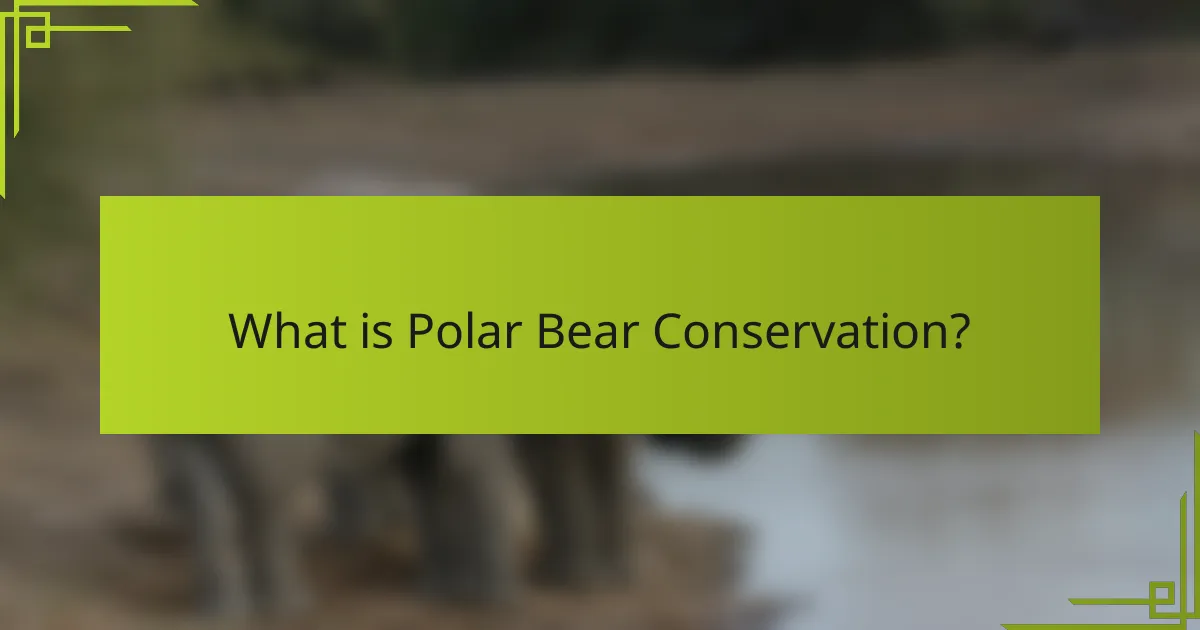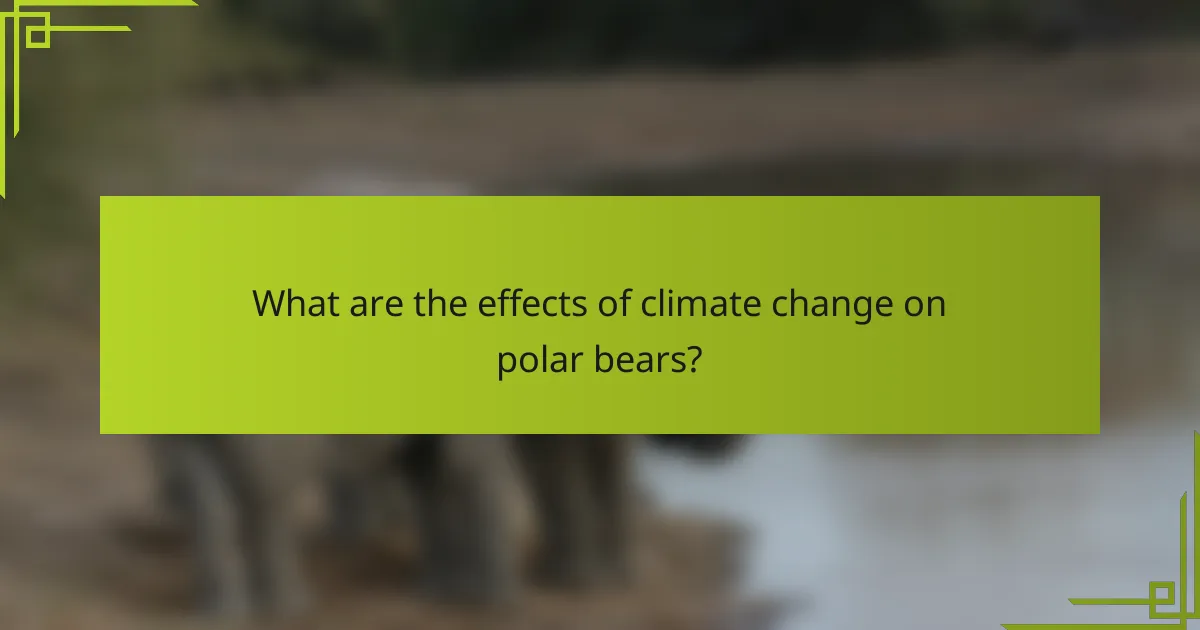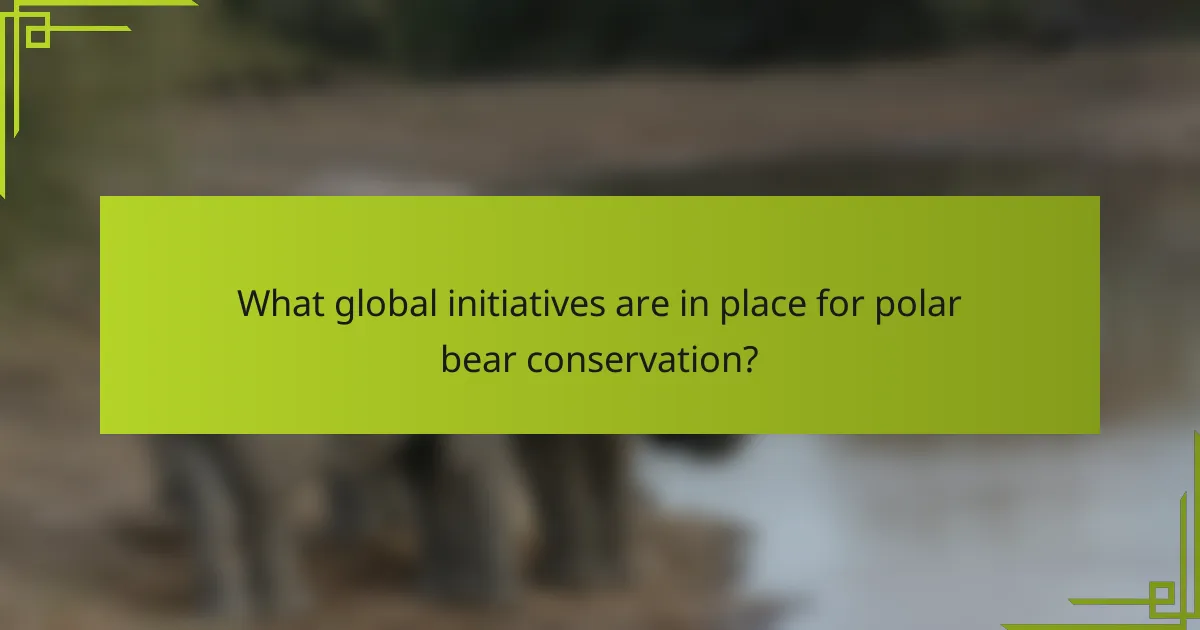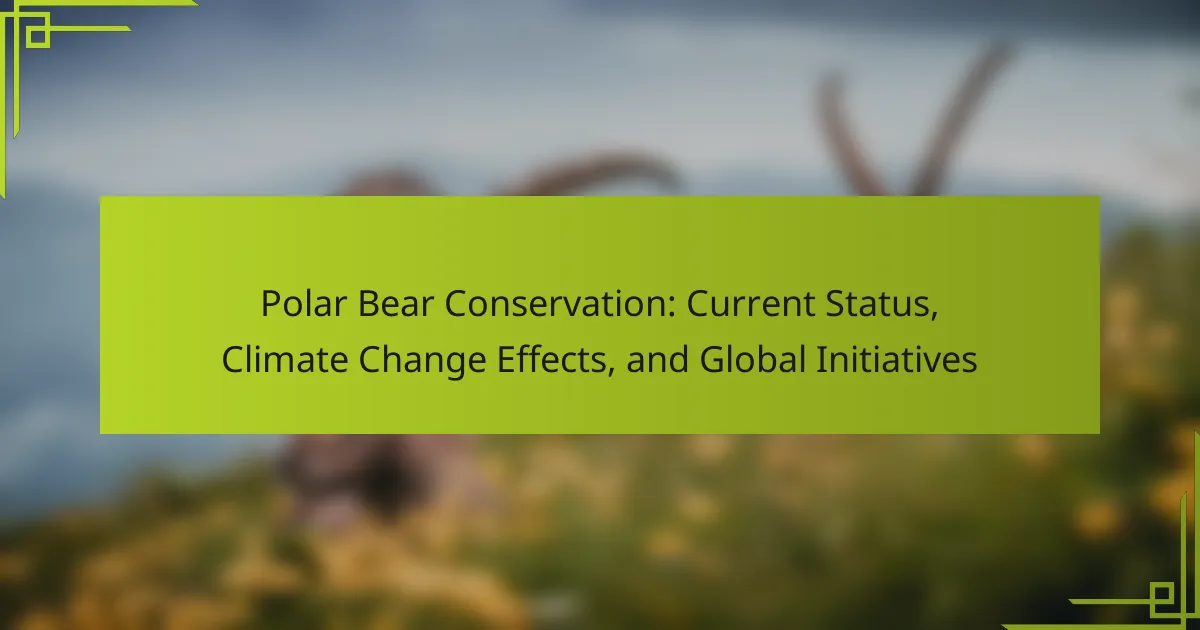Polar Bear Conservation focuses on the protection and preservation of polar bear populations and their habitats, which are increasingly threatened by climate change, habitat loss, and human activities. As global temperatures rise, the critical sea ice that polar bears depend on for hunting seals is rapidly diminishing, leading to malnutrition and declining reproductive rates among these animals. Key global initiatives, such as the Polar Bear Conservation Plan and the Arctic Council’s Conservation of Arctic Flora and Fauna (CAFF) initiative, aim to address these challenges through habitat protection, research, and international cooperation. Organizations like the World Wildlife Fund and the International Union for Conservation of Nature play vital roles in advocating for effective policies and funding to ensure the survival of polar bears and the integrity of the Arctic ecosystem.

What is Polar Bear Conservation?
Polar Bear Conservation involves efforts to protect and preserve polar bear populations and their habitats. This conservation is crucial due to the threats posed by climate change, habitat loss, and human activities. Polar bears rely on sea ice for hunting seals, their primary food source. As global temperatures rise, sea ice is diminishing, endangering their survival. Conservation initiatives include habitat protection, research, and policies aimed at reducing greenhouse gas emissions. Organizations like the World Wildlife Fund and various governments work collaboratively to implement these strategies. Effective conservation can help maintain polar bear populations and the Arctic ecosystem.
Why is Polar Bear Conservation important?
Polar Bear Conservation is important because polar bears are a keystone species in their Arctic ecosystem. Their presence indicates the health of the marine environment. As top predators, they help maintain the balance of species below them in the food chain. Climate change threatens their habitat, leading to declining ice levels. This loss of ice affects their ability to hunt and reproduce. According to the World Wildlife Fund, polar bear populations are declining due to these environmental changes. Protecting polar bears also helps preserve the biodiversity of the Arctic. Additionally, their conservation raises awareness about broader climate issues.
What role do polar bears play in their ecosystem?
Polar bears are apex predators in their ecosystem. They primarily hunt seals, which helps regulate seal populations. This predation maintains the balance of marine ecosystems. Additionally, polar bears contribute to nutrient cycling. Their hunting activities lead to seal carcasses, which provide food for scavengers. They also influence the distribution of prey species. By doing so, polar bears help maintain biodiversity in Arctic habitats. Their presence indicates a healthy ecosystem, reflecting the overall health of their environment.
How do polar bears contribute to biodiversity?
Polar bears contribute to biodiversity by maintaining the balance of marine ecosystems. They are apex predators, primarily preying on seals. This predation regulates seal populations, which in turn affects the structure of the marine community. Healthy seal populations support diverse marine life. Polar bears also facilitate nutrient cycling through their hunting and feeding behaviors. Their waste provides essential nutrients to the Arctic ecosystem. Additionally, polar bears serve as indicators of climate change and ecosystem health. Their presence reflects the state of their habitat and the impacts of environmental changes.
What are the current challenges facing polar bear populations?
Polar bear populations face significant challenges primarily due to climate change. The melting of Arctic sea ice reduces their habitat and hunting grounds. This leads to decreased access to their primary prey, seals. As a result, polar bears struggle to find sufficient food. Additionally, climate change causes habitat fragmentation. This can isolate bear populations, making breeding more difficult. Furthermore, increased human activity in the Arctic poses risks. Oil exploration and shipping can lead to habitat disturbance and pollution. These factors contribute to the overall decline in polar bear populations. According to the U.S. Fish and Wildlife Service, polar bears are classified as vulnerable due to these ongoing threats.
How does habitat loss affect polar bear survival?
Habitat loss significantly affects polar bear survival by reducing their access to essential hunting grounds. As sea ice diminishes due to climate change, polar bears struggle to find seals, their primary food source. This leads to malnutrition and decreased reproductive rates. According to the U.S. Geological Survey, polar bear populations in the Arctic are declining as their habitat continues to shrink. The loss of sea ice also forces polar bears to travel greater distances, increasing energy expenditure. Ultimately, habitat loss threatens the long-term viability of polar bear populations.
What are the impacts of human activity on polar bears?
Human activity significantly impacts polar bears. Climate change, driven by human-induced greenhouse gas emissions, leads to habitat loss. The melting of sea ice reduces hunting grounds for polar bears. This forces them to travel longer distances to find food. Increased human activity, such as shipping and oil exploration, disrupts their natural habitat. Pollution from industrial activities contaminates their environment. Additionally, human-wildlife conflict has risen due to habitat encroachment. These factors contribute to declining polar bear populations and threaten their survival.

What are the effects of climate change on polar bears?
Climate change significantly affects polar bears. It leads to the melting of sea ice, which is crucial for their hunting and breeding. As temperatures rise, the Arctic ice diminishes at a rate of approximately 13 percent per decade. This loss reduces polar bears’ access to seals, their primary food source. Consequently, polar bears experience malnutrition and decreased reproductive rates. Additionally, climate change alters their habitat, forcing bears to travel greater distances for food. Increased competition for resources also arises as bears are pushed into smaller areas. These factors contribute to the overall decline in polar bear populations.
How is climate change impacting polar bear habitats?
Climate change is significantly impacting polar bear habitats. The warming climate leads to the melting of sea ice in the Arctic. Polar bears rely on sea ice for hunting seals, their primary food source. As ice diminishes, bears have to travel greater distances to find food. This results in increased energy expenditure and lower reproductive rates. Research indicates that the Arctic is warming at twice the global average rate. According to the National Snow and Ice Data Center, Arctic sea ice extent has decreased by over 40% since the late 1970s. The loss of habitat threatens the survival of polar bear populations.
What changes are occurring in Arctic sea ice?
Arctic sea ice is declining in both extent and thickness. Satellite data shows that Arctic sea ice extent has decreased by approximately 40% since the late 1970s. The summer minimum ice extent has reached record lows, with 2012 being the lowest recorded year. Additionally, the thickness of the ice has reduced, leading to thinner, more fragile ice. This decline affects marine ecosystems and species that depend on sea ice, including polar bears. Polar bears rely on sea ice for hunting seals, their primary food source. The loss of ice habitat threatens their survival and reproductive success.
How does melting ice affect polar bear hunting and feeding?
Melting ice significantly impacts polar bear hunting and feeding. As sea ice diminishes, polar bears lose their primary hunting grounds for seals. Seals are their main food source and rely on ice for breeding and resting. With less ice, bears must swim longer distances to find food. This increased energy expenditure can lead to malnutrition and decreased reproduction rates. Research indicates that polar bear populations are declining in areas with rapid ice loss. According to the U.S. Geological Survey, some populations have seen declines of over 50% in the last few decades due to these changes.
What are the physiological effects of climate change on polar bears?
Climate change adversely affects polar bears’ physiology. Rising temperatures lead to habitat loss, particularly sea ice, which is essential for hunting seals. Polar bears rely on sea ice to access their primary food source. As ice diminishes, bears must swim longer distances to find food. Increased swimming can lead to exhaustion and decreased body condition.
Additionally, climate change affects the availability of prey. Reduced seal populations impact polar bear nutrition. Malnutrition can result in lower reproductive rates and higher mortality. Studies show that thinner bears have lower cub survival rates.
Increased temperatures also lead to higher stress levels in polar bears. Stress can affect their immune systems, making them more susceptible to diseases. Overall, climate change poses significant physiological challenges for polar bears, threatening their survival.
How does warming affect polar bear health and reproduction?
Warming negatively affects polar bear health and reproduction. As temperatures rise, sea ice diminishes, reducing hunting grounds for polar bears. This leads to malnutrition and decreased body condition. Poor health impacts reproductive success, resulting in lower cub survival rates. Studies show that thinner bears have fewer cubs. Additionally, warming disrupts the timing of breeding seasons. This misalignment can further reduce the chances of successful reproduction. Overall, climate change poses a significant threat to polar bear populations.
What adaptations are polar bears making in response to climate change?
Polar bears are adapting to climate change by altering their hunting behaviors and shifting their range. They are increasingly relying on land-based food sources due to diminishing sea ice. This includes scavenging on carcasses and foraging for vegetation. Some polar bears are also extending their seasonal movements to find stable ice. Research indicates that these adaptations are critical for their survival as ice habitats decline. A study published in “Ecology and Evolution” highlights these behavioral changes in response to habitat loss.

What global initiatives are in place for polar bear conservation?
Global initiatives for polar bear conservation include the Polar Bear Conservation Plan and the Arctic Council’s Conservation of Arctic Flora and Fauna (CAFF) initiative. The Polar Bear Conservation Plan, established by the U.S. Fish and Wildlife Service, aims to protect polar bear populations and their habitat. It emphasizes research, monitoring, and management strategies to mitigate threats. The CAFF initiative promotes cooperation among Arctic nations to safeguard biodiversity, including polar bears. Additionally, the International Polar Bear Conservation Strategy focuses on habitat preservation and climate change adaptation. These initiatives are supported by organizations like WWF and the IUCN, which advocate for policy changes and funding for conservation efforts.
What organizations are leading polar bear conservation efforts?
The leading organizations in polar bear conservation efforts include the World Wildlife Fund (WWF), Polar Bears International, and the U.S. Fish and Wildlife Service. WWF focuses on habitat protection and climate change advocacy. Polar Bears International emphasizes education and research on polar bear ecology. The U.S. Fish and Wildlife Service manages the polar bear population under the Marine Mammal Protection Act. These organizations collaborate on initiatives to protect polar bear habitats and raise awareness about the impacts of climate change. Their combined efforts aim to ensure the survival of polar bears in a changing environment.
What strategies do these organizations employ?
Organizations employ various strategies for polar bear conservation. These strategies include habitat protection, research initiatives, and community engagement. Habitat protection involves establishing protected areas to safeguard polar bear habitats from industrial activities. Research initiatives focus on studying polar bear populations, their behaviors, and the impacts of climate change. Community engagement promotes local involvement in conservation efforts. Education programs raise awareness about polar bears and their ecological importance. Collaborative efforts among international organizations enhance resource sharing and strategy development. These strategies aim to mitigate threats and promote the long-term survival of polar bears in a changing climate.
How do these organizations collaborate with local communities?
Organizations collaborate with local communities through various initiatives. They engage in education programs to raise awareness about polar bear conservation. These programs often include workshops and community meetings. Organizations also provide resources for sustainable practices that benefit both the community and polar bears. They involve local residents in research efforts, allowing them to contribute valuable traditional knowledge. Collaborative projects may include habitat restoration and monitoring polar bear populations. Funding and support are often directed towards community-led conservation efforts. This partnership fosters a sense of ownership and responsibility towards wildlife conservation.
What policies are being implemented to protect polar bears?
Various policies are being implemented to protect polar bears. The Marine Mammal Protection Act in the U.S. prohibits the hunting and harassment of polar bears. The Endangered Species Act provides additional protections for polar bear populations. Internationally, the Agreement on the Conservation of Polar Bears aims to coordinate efforts among Arctic nations. These policies focus on habitat conservation and the reduction of greenhouse gas emissions. The U.S. Fish and Wildlife Service monitors polar bear populations and their habitats. Additionally, local community involvement is encouraged in conservation efforts. These measures are critical as polar bears face threats from climate change and habitat loss.
How do international treaties impact polar bear conservation?
International treaties significantly impact polar bear conservation by establishing legal frameworks for protection. These treaties, such as the Marine Mammal Protection Act and the Convention on International Trade in Endangered Species, regulate hunting and trade. They create guidelines for habitat preservation and climate change mitigation. The treaties promote international cooperation among nations sharing polar bear habitats. For instance, the 1973 Agreement on the Conservation of Polar Bears involves Canada, the U.S., Russia, Norway, and Denmark. This agreement aims to ensure sustainable management and conservation efforts across borders. Additionally, treaties facilitate research and data sharing, enhancing conservation strategies. Overall, international treaties play a crucial role in safeguarding polar bear populations and their habitats.
What role do national governments play in polar bear protection?
National governments play a crucial role in polar bear protection through legislation and conservation efforts. They establish laws that regulate hunting and habitat protection. For example, in the United States, the Marine Mammal Protection Act safeguards polar bears. In Canada, the Species at Risk Act provides legal protection for polar bears and their habitats. National governments also participate in international agreements, such as the Polar Bear Conservation Management Plan. These agreements promote collaboration among countries to address climate change and habitat loss. Governments fund research to monitor polar bear populations and assess threats. They also engage in public education campaigns to raise awareness about polar bear conservation. Through these actions, national governments significantly contribute to the protection of polar bears and their ecosystems.
What can individuals do to support polar bear conservation?
Individuals can support polar bear conservation by reducing their carbon footprint. This can be achieved through using energy-efficient appliances and driving less. Supporting renewable energy sources also helps decrease greenhouse gas emissions. Additionally, individuals can participate in local conservation efforts. Volunteering for wildlife organizations aids in habitat preservation. Educating others about polar bear conservation raises awareness. Donations to reputable conservation groups provide necessary funding for research and protection initiatives. Lastly, advocating for policies that address climate change contributes to long-term solutions for polar bear survival.
How can awareness and education contribute to polar bear conservation?
Awareness and education significantly contribute to polar bear conservation by fostering understanding and promoting action. Increased public knowledge about polar bears’ ecological role encourages support for conservation initiatives. Educational programs can inform communities about the impacts of climate change on polar bears. Informed individuals are more likely to advocate for policies that protect their habitats. Studies show that awareness campaigns can lead to increased donations for conservation organizations. For example, the World Wildlife Fund reported a 30% increase in donations following awareness initiatives. Education also empowers local communities to engage in sustainable practices that benefit polar bears. Overall, awareness and education create a more informed public that actively participates in conservation efforts.
What actions can people take to reduce their carbon footprint for polar bears?
People can reduce their carbon footprint for polar bears by adopting sustainable practices. Reducing energy consumption at home lowers greenhouse gas emissions. Using energy-efficient appliances and LED lighting can significantly decrease energy use. Opting for renewable energy sources like solar or wind power further minimizes carbon output. Reducing car travel and using public transportation or biking cuts down on fossil fuel consumption. Supporting local and sustainable food options reduces the carbon footprint associated with food transportation. Minimizing waste through recycling and composting also helps lower emissions. Engaging in advocacy for climate policies promotes systemic changes that benefit polar bear habitats.
Polar Bear Conservation focuses on the protection and preservation of polar bear populations and their habitats, which are increasingly threatened by climate change, habitat loss, and human activities. Key aspects include the role of polar bears as a keystone species in the Arctic ecosystem, the challenges they face due to declining sea ice, and the impact of human activity on their survival. The article also outlines global initiatives and policies aimed at conserving polar bears, emphasizing the importance of community involvement and individual actions to support these efforts. Understanding these elements is crucial for addressing the ongoing threats to polar bears and their habitats.
